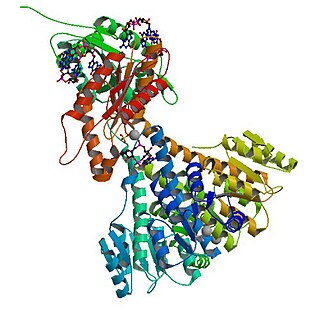A cyclase is an enzyme, almost always a lyase, that catalyzes a chemical reaction to form a cyclic compound. Important cyclase enzymes include:

Enzymes are macromolecular biological catalysts that accelerate chemical reactions. The molecules upon which enzymes may act are called substrates, and the enzyme converts the substrates into different molecules known as products. Almost all metabolic processes in the cell need enzyme catalysis in order to occur at rates fast enough to sustain life. Metabolic pathways depend upon enzymes to catalyze individual steps. The study of enzymes is called enzymology and a new field of pseudoenzyme analysis has recently grown up, recognising that during evolution, some enzymes have lost the ability to carry out biological catalysis, which is often reflected in their amino acid sequences and unusual 'pseudocatalytic' properties.
In biochemistry, a lyase is an enzyme that catalyzes the breaking of various chemical bonds by means other than hydrolysis and oxidation, often forming a new double bond or a new ring structure. The reverse reaction is also possible. For example, an enzyme that catalyzed this reaction would be a lyase:

Catalysis is the process of increasing the rate of a chemical reaction by adding a substance known as a catalyst, which is not consumed in the catalyzed reaction and can continue to act repeatedly. Because of this, only very small amounts of catalyst are required to alter the reaction rate in principle.
- Adenylyl cyclase, which forms cyclic AMP from adenosine triphosphate (EC 4.6.1.1)

Adenylyl cyclase type 2 is an enzyme typically expressed in the brain of humans, that is encoded by the ADCY2 gene. It belongs to the adenylyl cyclase class-3 or guanylyl cyclase family because it contains two guanylate cyclase domains. ADCY2 is one of ten different mammalian isoforms of adenylyl cyclases. ADCY2 can be found on chromosome 5 and the "MIR2113-POU3F2" region of chromosome 6, with a length of 1091 amino-acids. An essential cofactor for ADCY2 is magnesium; two ions bind per subunit.

Adenylyl cyclase type 3 is an enzyme that in humans is encoded by the ADCY3 gene.

Adenylyl cyclase type 4 is an enzyme that in humans is encoded by the ADCY4 gene.
- Guanylyl cyclase, which forms cyclic GMP from guanosine triphosphate (EC 4.6.1.2)

Guanylate cyclase soluble subunit alpha-2 is an enzyme that in humans is encoded by the GUCY1A2 gene.

Guanylate cyclase soluble subunit alpha-3 is an enzyme that in humans is encoded by the GUCY1A3 gene.

Guanylate cyclase soluble subunit beta-1 is an enzyme that in humans is encoded by the GUCY1B3 gene.
- Protein cyclase, a ligase enzyme that produces backbone-cyclised proteins by intramolecular transpeptidation

Adenylyl cyclase is an enzyme with key regulatory roles in essentially all cells. It is the most polyphyletic known enzyme: six distinct classes have been described, all catalyzing the same reaction but representing unrelated gene families with no known sequence or structural homology. The best known class of adenylyl cyclases is class III or AC-III. AC-III occurs widely in eukaryotes and has important roles in many human tissues.

Adenosine triphosphate (ATP) is a complex organic chemical that provides energy to drive many processes in living cells, e.g. muscle contraction, nerve impulse propagation, and chemical synthesis. Found in all forms of life, ATP is often referred to as the "molecular unit of currency" of intracellular energy transfer. When consumed in metabolic processes, it converts either to adenosine diphosphate (ADP) or to adenosine monophosphate (AMP). Other processes regenerate ATP so that the human body recycles its own body weight equivalent in ATP each day. It is also a precursor to DNA and RNA, and is used as a coenzyme.

Adenylyl cyclase type 1 is an enzyme that in humans is encoded by the ADCY1 gene.
| This set index page lists enzyme articles associated with the same name. If an internal link led you here, you may wish to change the link to point directly to the intended article. |








